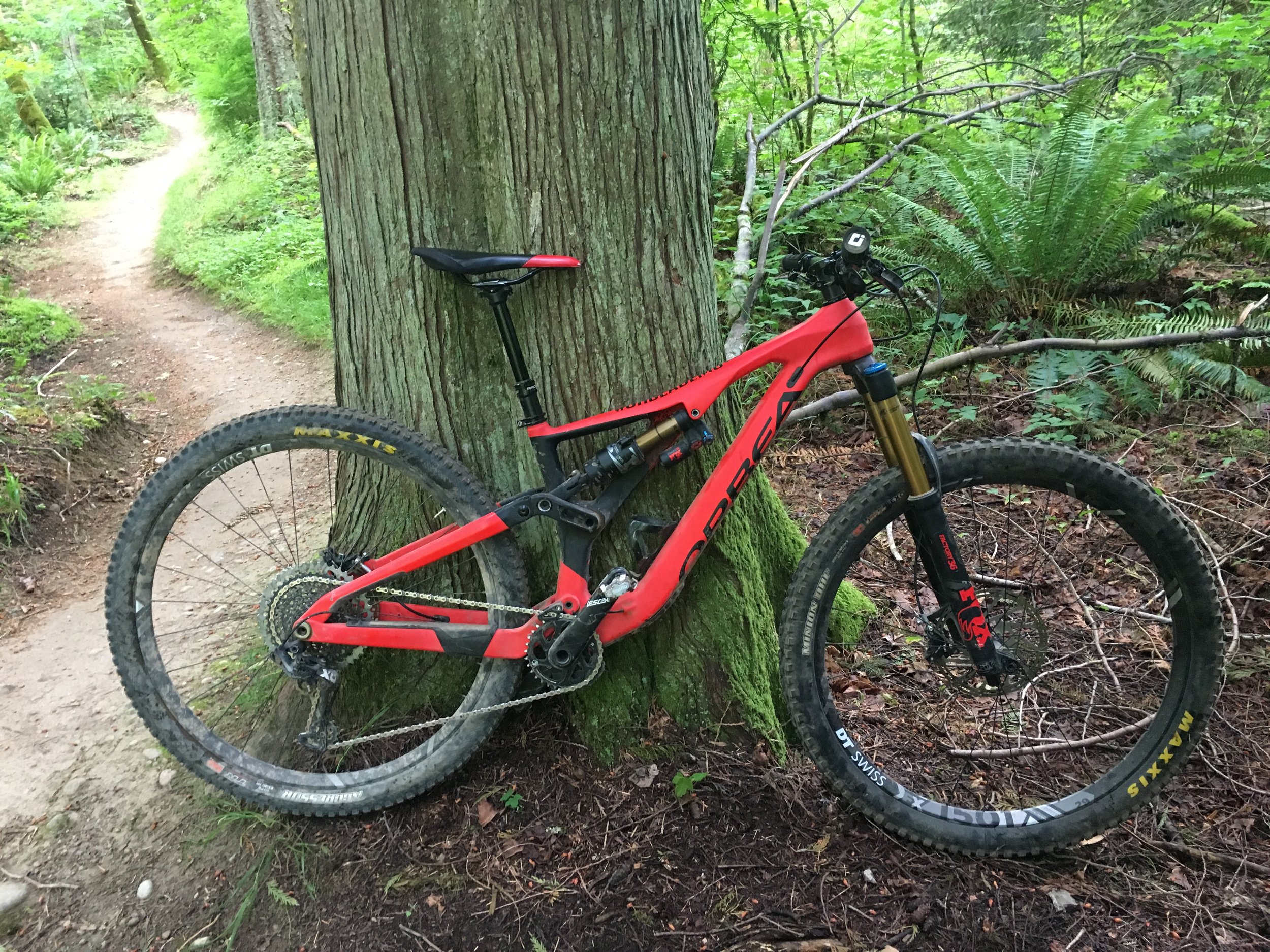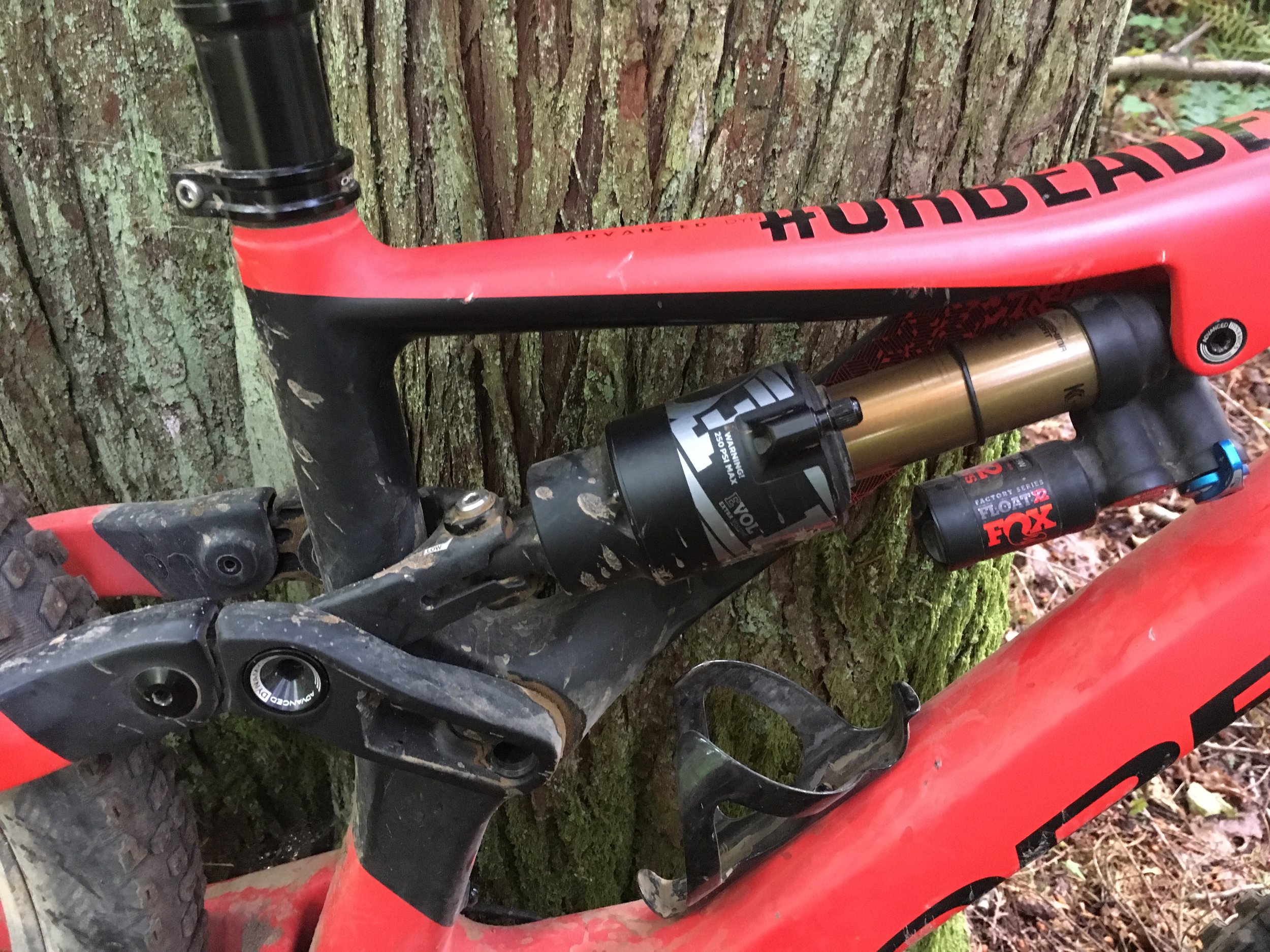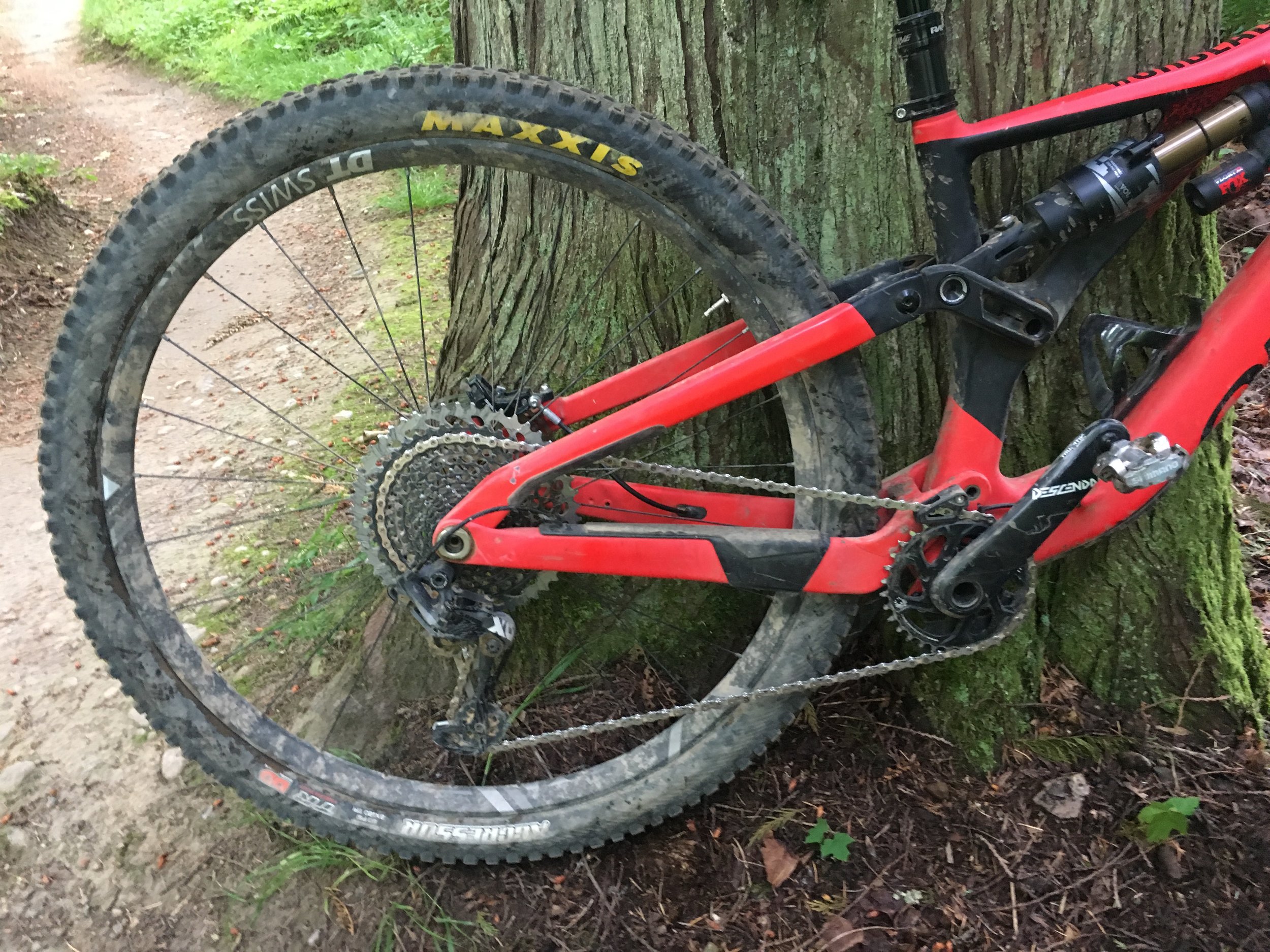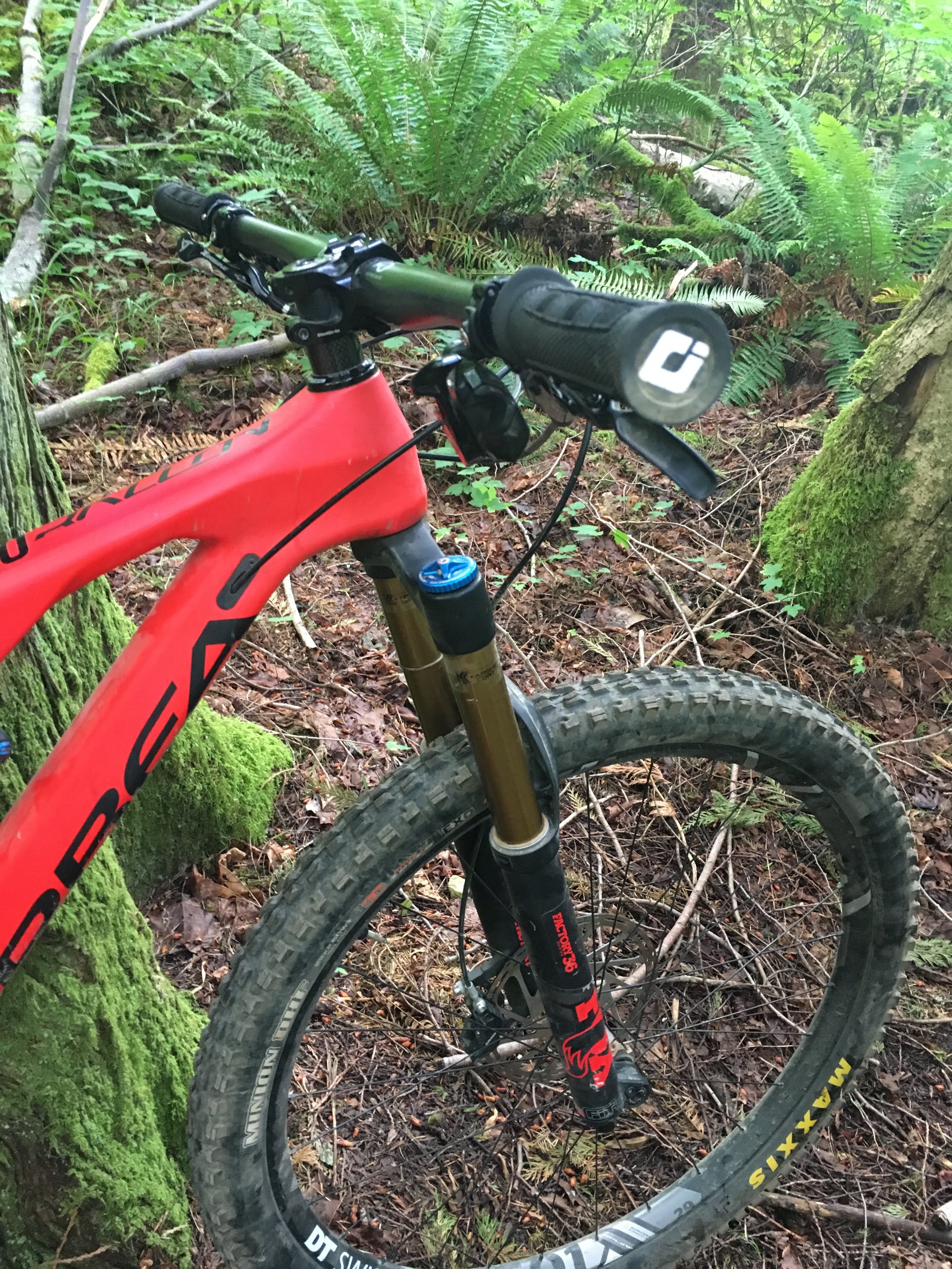The Orbea Rallon is an awesome ride for high speeds and steep descents.
Read More



Blog - Reviews & Posts
The Orbea Rallon is an awesome ride for high speeds and steep descents.
Read MoreComparison test of modern 29er trail bikes: Pivot Trail 429, Santa Cruz Tallboy, Yeti SB 4.5, Yeti SB100
Read MoreThe SB5.5 is one of the best bikes that I've ridden in the past several years balancing downhill stability with a nimble feel suited for trail riding on days when you're not just blasting downhill.
Being 5’9” (175cm) in height, I’m at the cusp of being just being tall enough for 29er geometry to work well. My experience is that the increased size of 29er wheels vs that of a 27.5” wheel for medium sized frames results in slacker and slower steering geometry. Though many 29er bikes climb well and have better stability going downhill than 27.5” wheeled bikes, the shortcoming from a perspective of my ride preferences is that many of them require extra effort to steer around even moderately tight corners than an equivalent 27.5” bike resulting in a less intuitive, flowy handling feel.
I tend to look for bikes that are well-suited for being one-quiver bikes. Generally, I feel that these bikes balance good downhill ability with decent level of nimbleness for everyday trail riding along with good climbing efficiency and feel. Some bikes optimize for one or two of these factors and do make sense for either for racers in gravity-oriented events or XC race events. Most non-racers though ride a variety of terrain for which they’ll need to climb to enjoy the descents and are often on trails that aren’t always pointed straight uphill or downhill. Bikes that are good at descending, climbing and nimble handling feel tend to be the one that are most suitable for being that one-quiver, do-it-all bike.
The SB5.5 climbs well, if perhaps only missing the final iota of firmness at the pedal and efficiency that some dw-link bikes can provide. With its 29er wheels and Switch Infinity suspension, I had expected the SB5.5 to climb like a mountain goat. While it was a solid climber, the initial acceleration when applying pedal force was perhaps a bit less immediate than I would have expected. That said, once the 29er wheels were rolling, the SB5.5 felt like a locomotive in its ability to maintain speed on less steep climbs and flat terrain. One factor that might have impacted my impressions were that the Maxxis Aggressor rear tire on the SB5.5 demo bike I rode didn’t seem to roll all that well despite apparently being designed as faster rolling than the Maxxis Minion DH-R. If increasing climbing speed is of interest to you for the SB5.5, I might suggest running a Schwalbe Nobby Nic as a rear tire paired with the Maxxis Minion DH-F in front. If better cornering traction is more important, I would suggest running the DH-R that has better cornering traction while still rolling surprisingly well. See our 2016 enduro tire report for more details. (https://www.dirtmerchantbikes.com/special-events/2016/5/13/pacific-northwest-spring-2016-endurotrail-tire-test-hans-dampfnobby-nic-dh-fdh-r-butcherpurgatory). We’ll probably run a comparison test this year comparing the DH-R, Nobby Nic and Aggressor as rear tires, but based on my initial impressions, it doesn’t seem to make sense to run the Aggressor as a compromise between the DH-R with better cornering traction and the Nobby Nic with better rolling resistance and feel.
This is where the SB5.5 really was outstanding from a perspective of fit for everyday trail riding along with confidence when riding steeper terrain. Despite head angle and wheelbase numbers that are actually on the steeper & shorter side, the SB5.5’s 29er wheels provide a welcome degree of stability on steeper terrain. The roll over capability and perhaps the greater gyroscopic effect of the larger 29er wheels provides confidence that the SB5.5 goes where you point it. The steeper head tube angle & shorter wheelbase combined with the stability of the 29er wheels provides a somewhat uncommon combination of stability and nimbleness.
Where I was really impressed by the SB5.5 was its cornering ability despite having 29er wheels. Though not quite as quick to turn as some bikes with 27.5” wheels, the SB5.5 handles fast enough to not feel like its slowing you down in tighter singletrack. This is generally the aspect that has turned me off to many 29er bikes especially those from earlier generations of 29er for which handing agility was not a primary design consideration. It was only on super tight switchback turns that are difficult to clean on any bike that the SB5.5 felt somewhat long. The SB5.5’s relatively nimble handling balance is what makes it highly suitable for a one-quiver bike that works well on a wide variety of terrain.
I think the SB5.5 is able to balance downhill stability with nimble handling as Yeti has leveraged the roll over capabilities of 29er wheels to balance out slightly faster handling geometry. Here are specs for some long-travel 29ers so you can compare yourself.
Long travel 29er bikes - Geometry specs
Though Yeti’s Switch Infinity suspension design (https://youtu.be/E2J873o4skI) may seem complex, the mechanics at Yeti shops I’ve spoken with uniformly agree that it is a more durable design than Yeti’s previous Switch design (https://youtu.be/RXXfhbrng5o) with the rotating eccentric cam (https://www.pinkbike.com/news/Yetis-Chris-Conroy-Talks-About-the-SB-66-Suspension.html). Both designs work well in drier climates, but the rain and mud in the Pacific Northwest can cause contamination of the eccentric cam of the earlier Switch design. The newer Switch Infinity design is apparently easier to clean and maintain, holding up better in wet climates such as ours
Comparing the SB5.5 to the SB6 which I’ve also ridden on the same trails, I would pick the SB5.5 as my everyday bike. The SB6 has great stability, but felt sluggish to me on flatter and tighter trails. The SB5.5’s 29er wheels seem to provide almost the same level of stability as the SB6 with geometry that is steeper and faster steering. For enduro racing, I don’t have enough back-to-back riding experience on both to make a judgment, but would suggest riding both the SB6 and SB5.5 if you’re interested in getting a Yeti.
I really had a LOT of fun riding the SB5.5. It inspired confidence on steeper, looser trails while still feeling decently quick on tighter singletrack.
Rating Guide
5 stars - Absolutely outstanding
4 stars
3 stars - Solid performance, meets expectations
2 stars
1 star - Misses expectations by a wide margin
Carbon Wheels compared in an A/B test format
Read MoreCutaway of 6D's Omni-Directional Suspension
I was at the Interbike tradeshow for the bike industry this past September and learned about a new bike helmet technology that reduces the force of common low speed impacts. With all of the recent news about how concussions and even sub-concussive level forces can impact brain function, I thought this might be worth sharing for all of you that ride bikes or have kids that ride bikes.
Both of my kids play club soccer and it's been REALLY eye-opening about how long kids with concussions are now required to abstain from activities posing potential risk of additional head impacts after an initial concussion. One of my son's soccer teammates sat out from playing after receiving a concussion for about 5 months on doctor's orders. What's particularly concerning to me is that repeated impacts of even a sub-concussive level may have long-term health effects (though the science on this is far from settled). One example of a study that came up with evidence of this was a study that found functional cognitive impairment in high school football players that had not experienced clinically-diagnosed concussions: https://www.ncbi.nlm.nih.gov/pubmed/20883154. In this study, researcher found that the players with the most impaired visual memory skills were actually not those that had experienced concussions but rather the players which, in the preceding week, had experienced a large number of subconcussive hits - around 150 hits - mostly in the 40 to 80 g range. The Purdue researchers suspect that these players experienced neurological trauma arising from repeated, sub-concussive head collision events, each of which likely produces sub-clinical stress on neural tissue in the brain.
Existing bicycle helmet crash tests focus mainly on reducing the risk of skull fractures from high speed impacts, but increasing the density of helmet foams to reduce the risk of skull fractures in higher speed crashes actually reduces effectiveness at reducing forces from lower speed crashes. The density of bike helmet foam necessary to meet current crash standards is more firm than ideal to adequately absorb the impact from lower speed crashes at a level that would cause concussions. Adding a softer helmet layer to existing bike helmet designs would be one way tohelp slow down the acceleration of the head in these lower speed crashes.
6D's Omni-Directional Suspension Damper
One of the new technologies that I was really excited to find at the Interbike bike industry trade show this past September was 6D Helmets' Omni-Directional Suspension (ODS) technology that helps reduce forces transmitted in low speed impacts. 6D's technology adds a layer of rubber bumpers between two foam layers to reduce impact speed and force (see attached picture). The NFL chose 6D and its ODS technology to beone of 5 finalists chosen out of 125 entries in the NFL's Head Health Challenge III (https://ninesights.ninesigma.com/web/head-health/challenge-3-winners) to discover, design & develop advanced materials that better absorb or dissipate impact. I was so impressed that I got a 6D bike helmet for myself and will get them for my family as well.
6D's Omni-Directional Suspension reduces and delays the force transmitted in low speed impacts.
If you're interested in more details, I've posted a video of Bob Weber, co-founder of 6D Helmets, talking about how their technology works. It's located at: https://www.dirtmerchantbikes.com/special-events/2016/10/4/interbike-2016-video-6d-helmets-reduction-of-concussion-level-forces-in-bike-crashes
Some great new components from Praxis Works. First up is their new 1x Wave chain ring. This has a Left-Right tooth orientation they claim will create less noise & drag than a standard narrow-wide ring. It comes in SRAM Direct Mount as well as 104 & 94 BCD sizes.
Also new from Praxis Works are their Lyft carbon cranks. The cranks weigh 454 grams with a Direct Mount chain ring. As we have come to expect from Praxis Works, their new crank will fit a wide range of bottom bracket standards including BSA Threaded, BB30, PF30, BB90, BB92 bottom brackets. The Lyft crankset will be available by December 2016.
Giro has introduced a new version of their Empire ACC and Republic LX shoes for road and casual use that are 100% reflective! These look to be a great option for road riding or commuting in night time or low light conditions.
Read MoreErgon have added a new version of their GE1 grip designed for wide handlebars. The new version has a softer rubber compound that is extra grippy in both wet & dry conditions. We'll look to get a pair to add to our current grips comparison test that also includes the ODI Ruffian, ODI Elite Pro, Chromag SquareWave & Ergon GA2 grips.
Ergon are also introducing their new IP3 Solestar insole intended to improve both comfort and power transfer. The IP3 uses a nylon structure to create a solid structure for the foot. The IP3 will be offered in 6 sizes.
New seatposts and drop bars from Thomson.
Read MoreKool-Stop showed new aluminum cooling fins with a replaceable brake pad design that allows standard Kool-Stop pads to be used as replacement.
Read MoreAfter learning about 6D Helmet's Omni-Directional Suspension (ODS), not only am I getting one for myself but have decided to sign up Dirt Merchant Bikes as an authorized 6D retailer. If you find this blog post to be helpful, please consider buying a 6D helmet from us. We offer free shipping on orders over $50 and no sales tax (including WA state)
Links to purchase 6D helmets are at:
6D ATB-1T Trail Helmet: http://www.dirtmerchantbikes.com/other-products/6d-atb-1t-trail-helmet
6D ATB-1 Carbon Attack Full Face Helmet: http://www.dirtmerchantbikes.com/other-products/6d-atb-1-carbon-attack-full-face-helmet
6D ATR-1Y Youth Full Face Helmet: http://www.dirtmerchantbikes.com/other-products/6d-atb-1y-youth-full-face-helmet
So my visit with 6D was originally intended as a 5 minute social call as one of my customers had just ordered a 6D Helmet and they had emailed me asking me to fill out a dealer application to complete the sale. To make a long story short, two hours later in the 6D booth, not only did I buy the helmet for my customer, but I also decided to buy a 6D helmet for myself, three 6D helmets for my wife & kids, and a full line of 6D full-face and half-shell demo helmets for customer sizing.
There are two types of impact forces that can be mitigated in addition to the high speed impact forces that all certified bike helmets are designed to reduce.
To date, bike helmet crash tests are still focused on mitigating the chance of skull fractures from higher speed impacts. To mitigate the higher impact forces mandated by crash tests, the EPS foam used in most helmets needs to be of a sufficiently high density. However, this higher density foam fails to provide much force reduction for lower speed impacts. Most bike helmets still do not do much to reduce the forces transmitted to the brain from lower speed impacts of the type that do happen frequently in mountain biking.
Compression and Shearing Forces on ODS Suspension
To my knowledge, 6D's Omni-Directional Suspension (ODS) is the only bicycle helmet technology that reduces all three of the impact forces that I have mentioned including:
6D does this with their ODS technology by adding elastomer (essentially tuned rubber) dampers between two layers of EPS foam that reduce lower speed impact forces and absorb rotational forces without any compromise to the helmets' ability to reduce forces transmitted in higher speed crashes.
This is Bob Weber talking about the design process for 6D Helmets' Omni-Directional Suspension (ODS) technology:
This is a demonstration of how the Omni-Directional Suspension (ODS) technology works:
This is a higher speed impact in AMA Supercross in which the 6D ODS' technology reduced both rotational and linear impact forces. You can see more details about this and other motocross crashes involving 6D helmets at http://www.racerxvt.com/article/interview-eddie-casillas-from-the-asterisk-mobile-medic-unit
Interested in learning more? Feel free to contact us at jeff@dirtmerchantbikes.com
OTHER REVIEWS OF 6D'S ODS TECHNOLOGY
APPENDIX
Bike helmets will typically meet one or more of these crash standards:
The SplitRail is a new hitch rack from RockyMounts that is a legitimate competitor to the Thule T2 Pro and Kuat NV hitch racks.
Read MoreThere have been some interesting articles in recent years on various chain lubes' ability to reduce drag.
This test conducted by Friction Facts (https://www.friction-facts.com/) claims that soaking a chain in melted paraffin reduces friction better than any commercial lube: https://www.scribd.com/doc/262044061/Velo-Friction-Facts-Chain-Lube-Efficiency-Tests
NOTE: If you decide to try the melted paraffin route, be VERY careful about melting the paraffin with a double boiler as paraffin can and DOES catch fire if heated to a high enough temperature. Ask me how I know. Anyhow, here are some directions for safely melting paraffin: http://www.candletech.com/candle-making/wax-melting-instructions/
Here's another review (http://biketestreviews.com/the-last-word-on-chain-lubrication/)that acknowledges that paraffin does indeed produce low friction for chains but not running a paraffin wax lubed chain in a straight line tends to shear the paraffin wax out from between the plates, pins and rollers fairly quickly so that all “lubrication” is gone, whereas a wet-lube will flow back into the chain once load and deflection have eased.
From my experience, I would agree with this assessment of paraffin especially for use in wet weather. It works great for a short amount of time, but requires extensive work frequently to resoak a chain in paraffin as paraffin lubed chains tend to get noisy pretty quickly. In terms of bike maintenance, I'm kind of a set-it-and-forget-it type of guy so using paraffin was far too fussy for me along with paraffin lubed chains easily getting rusty in wet weather.
I'm planning an upcoming test of chain lubes with a focus on durability. As chains on mountain bikes are subject to conditions that are often less than ideal (dirt, dust, water, etc.), my thought is that the durability of a chain lube is far more important than the absolute amount of friction reduction that it provides. Having the longest relube interval before a chain gets noisy might be one of the most important considerations for me.
In addition to what I think might be the two lubes with some of the best real-world effectiveness, perhaps adding motor oil might be also be a good inclusion to see if relatively cheap motor oil is a good substitute to far more expensive bike lube.
Thoughts? Interested in participating in the tests? Email me at jeff@dirtmerchantbikes.com.
Maxxis has taken the DH-F and DH-R tread patterns and applied them to Fat bike tire sizing to create the new Minion FBF and FBR tires
Read MoreDH-F, DH-R & High Roller now come in Plus-sized versions along with the Rekon+
Read MoreNew 2.6 tires from Maxxis & Schwalbe
Read MoreWe had a chance to speak to David Turner about the design philosophy for Turner Bikes' new Turner Flux v4.0. Here are David's thoughts on Turner's new bike design:
CLICK ON THE PICTURE BELOW TO ACCESS THE VIDEO >>>
The new Turner Flux v4.0
I got the chance to ride the SR Suntour Auron fork. Though the length of my ride wasn’t conducive to a head-to-head comparison vs the Rock Shox Pike fork, my initial impression is that the Auron fork is quite stiff and is perhaps stiffer than a Rock Shox Pike fork, which is itself not a noodle of a fork.
When I test ride bikes at Interbike, I can pretty quickly sort demo bikes out into three categories shortly after getting on dirt. The first category of demo bike are what I call the ‘½ loopers’ which I really want to get off of as quickly as possible by cutting off the test loop as short as I can. The second category are the ‘full loopers’ which I’m happy to ride for a full test loop. Finally the third category of demo bike are the ‘double loopers’ which I’d love to ride for two loops or more. The Alchemy Arktos fell squarely in this third category and I would have gladly gone out for a third loop if common sense didn’t prevail, counseling me to save my legs for ride time on some other demo bikes.
A common characteristic of bikes that I seem to like are that they uniformly seem to roll well and are good at maintaining momentum uphill, downhill and on flat trails with an almost e-bike level of glide while coasting. 29ers do this, but some of the best 27.5” bikes now can provide this feel as well. The Arktos indeed rolls really well providing that oh so enjoyable feeling of just flying along the trail. As discussed below in the climbing section of this review, I attribute this feeling to the Arktos’ Sine Suspension’s ability to absorb trail imperfections without hanging up on obstacles. In my experience, few other suspension designs work this fluidly absorbing trail obstacles with little loss of momentum.
Climbing – 4.5 stars
The Arktos is a great climbing bike, if perhaps only missing the final iota of firmness at the pedal and efficiency that some dw-link bikes can provide. One characteristic that I noticed about the Arktos was its ability to remain fully active on ledgy climbs. Unlike lesser suspension design, rolling up a ledge or rock resulted in no discernable pedal feedback or loss of momentum. In my rating scale, with average climbing bikes such as the current Specialized Stumpjumper rated a ‘3’ and better climbing bikes such as the current Santa Cruz Bronson rated a ‘4’, the Arktos’ exceptional bump absorbing ability while climbing warrants at least a slightly better climbing score than a ‘4’.
Descending - 5 stars
Descending on the Arktos was completely predictable and intuitive. Very much a point-and-shoot type of bike, the Arktos provides a level of confidence that helps riders to progress to and master tougher descents.
Cornering - 5 stars
Though the trails in Bootleg Canyon tend toward being more open without tight corners, the steering on the Arktos felt quick and intuitive but stable upon first impression. With steering that I perceived to be quicker than that of more DH-oriented enduro bikes such as the Yeti SB-6, Pivot Mach 6, and DeVinci Spartan, the Arktos will likely be a good all-around single bike quiver that is fun to ride on both steep descents and carving fast turns in tight singletrack. No bike does everything well, but the best bikes available today such as the Arktos are able to balance a range of virtues. More specialized designs such as enduro race replica bikes excel at stability and control on steep downhills but require cornering on flat trails to always be done over the handlebars to minimize understeer while faster handling designs can require a higher level of attention and confidence to ride fast downhill.
Summary: I had an absolutely fantastic time riding the Arktos both uphill and downhill and that fun to ride feeling is ultimately what a great bike is all about.
Rating Guide
5 stars - Absolutely outstanding
4 stars
3 stars - Solid performance, meets expectations
2 stars
1 star - Misses expectations by a wide margin
The DeVinci Django was quite nice to ride with slightly less climbing efficiency as its only real shortcoming compared only to the best climbing bikes.
Climbing – 4 stars
With its Dave Weagle designed Split Link suspension, the Django is quite an eager climbing bike with just a slightly less firm pedal feel than typically better climbing dw-link designs.
Descending – 5 stars
With a slacker head angle than some other bikes with a similar amount of suspension travel, the Django felt quite solid when descending. It had a similar handling balance to the longer travel DeVinci Troy (140mm travel).
Cornering - 4 stars
Cornering on the Django was quite predictable with perhaps slightly less sharpness in steering response compared to the new Turner Flux v4.0. On the flipside, though the Django may not turn in as quickly as the Flux, it also had a greater sense of stability when cornering than the Flux.
Summary:
The Django was quite fun to ride with perhaps only slightly less climbing efficiency as its only apparent shortcoming.
Rating Guide
5 stars - Absolutely outstanding
4 stars
3 stars - Solid performance, meets expectations
2 stars
1 star - Misses expectations by a wide margin
Dirt Merchant Bikes is the exclusive Seattle & Tacoma area dealer for Turner Suspension Bikes and Cleary Bikes for kids. Dirt Merchant Bikes provides mountain bike demos at Duthie Hill Mountain Bike Park in Issaquah, WA.
27101 Southeast Duthie Hill Road, Issaquah, WA, 98029